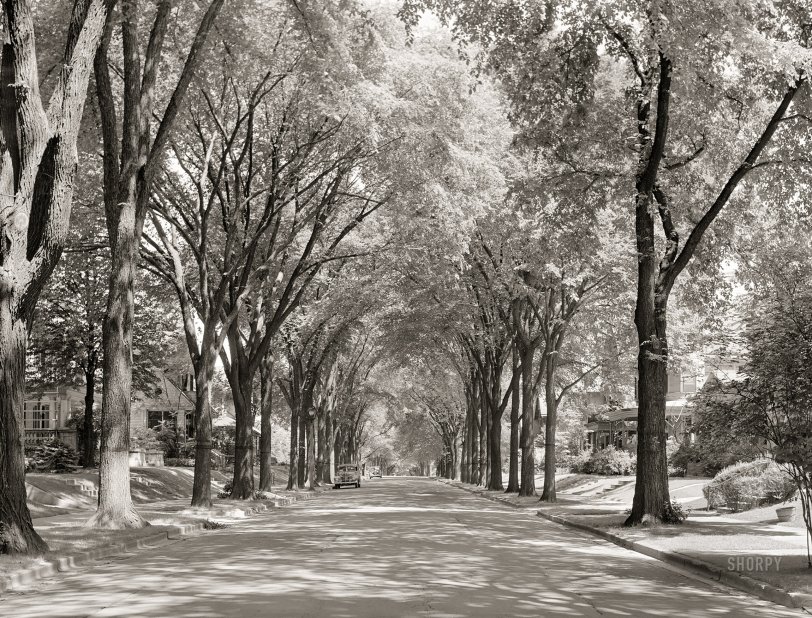


Framed or unframed, desk size to sofa size, printed by us in Arizona and Alabama since 2007. Explore now.
Shorpy is funded by you. Patreon contributors get an ad-free experience.
Learn more.

- Lofty addition
- In 1912
- Keenan Building
- Six years old
- Taken from the P.J. McArdle Roadway?
- It stood only 47 years
- Three track mind
- Incline to the right
- Reach for the sky, 1912 style
- No clean sweep
- Same Job Title, Same Face
- Sadly Lost
- Beautiful ...
- Where you get your kicks
- Aim High
- Pueblo Revival sisters
- Pueblo Neoclassicism
- Milk Man
- Regional dialect.
- Spielberg's inspiration
- Great Photo
- Loaf Story
- Do you still have the Rakes category?
- Could almost be a scene from the 1957 movie 'Hell Drivers'
- The Wages of Fear.
- Conspicuous by their absence
- Got Milk?
- All that aluminum
- No lefties
- Smoke 'em if you've got 'em
Print Emporium
Shady Pretty: 1941

June 1941. "Residential section. Milwaukee, Wisconsin." Take the "tree" out of Elm Street and you're left with Elm St. Medium format acetate negative by John Vachon. View full size.
The Old College Tree
One of the things I've cherished about my 40 year stay in Hanover, NH, is the grandeur of the disease resistant elms that remain in remarkable numbers on the Dartmouth College campus. You don't have them in rows like in this picture anymore, but you have some amazing samples dotted around campus. I stop and admire them almost every day. There's something about the interweave of the branches in the canopy that fascinates me.
Pre-emptive measures
When I was a kid, in the sixties, the local authorities in the cottage community where we spent our summers decided to cut down every elm in an over-zealous bid to nip this Dutch Elm thing in the bud, so to speak. All the elms on all the boulevards were cut down, leaving behind vacant vistas and strange weirdness. My mom was a tough bird brought up in the Depression, and I was surprised and not a little afraid at how upset she got.
Dutch elm disease
All over the northeast, elm trees were killed by this disease. when I was in elementary school in the 1940s, there was extensive spraying to kill the bark beetle that carried the disease fungus, but it was futile. Scenes like this do not exist today. Occasionally, in rural areas one will see a beautiful "fountain elm" standing, only because it's too far for the elm bark beetle to reach. Many of my generation remember the elms and miss them.
Bands
Most of these trees have a dark band a couple of inches wide, about 6 feet above ground-level. Not all are the same height, but it looks like they are all the same height at any one home. Anyone have any idea what these are?
[Insect barrier. - Dave]
Before the Dutch Elm virus
Before Dutch Elm disease ravaged them, all Midwestern cities had streets like this lined with elms, including my home town, Moline, Illinois. By 1980, most of the elms were gone.
My point was not that Dutch elm disease was caused by a virus; I know it's a fungus. The fungus blocks the 'veins' of the tree that deliver water and nutrients. I was comparing it to the corona virus. I'm sorry I wasn't clear.
[D.E.D. is caused by a fungus, not a virus. - Dave]
Elm Street
My hometown looked like that picture but by the mid 70's all of the elms were dead or dying thanks to Dutch Elm disease.
A Vague Memory
I was born in 1952 and do remember trees like this along the main street in my Ohio hometown. Was still pretty young so I don't remember too much about them going away. Just know that they are now long gone.
Like Elm Streets everywhere
Take the elms out of Elm St. and you have sad reality.
Still remember
My grandparents lived on a street very much like this in Milwaukee. I was very young, but remember the crews working their way up the street cutting down the remains of all the dead elms.
Alas, poor old stick
Can you grieve the loss of something you never experienced?
Yes, yes you can.
























On Shorpy:
Today’s Top 5